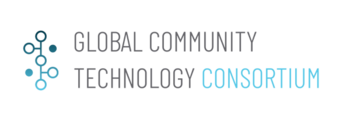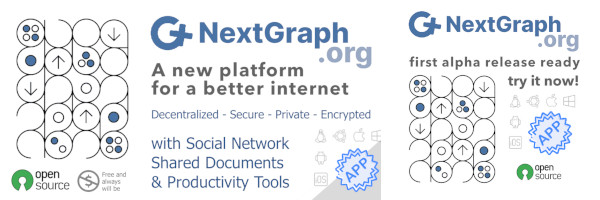NextGraph
| NextGraph | |
|---|---|

| |
 NextGraph | |
| Team Organizations | NGI |
| Team Leaders | Brian OConnor |
| Participating Municipalities | TBD |
| Status | Implemented |
| Initiative | Personal Data Store |
| Document | None |
Description
NextGraph is an innovative approach to building a truly decentralized internet, addressing critical issues like privacy, digital sovereignty, interoperability, and security. By merging peer-to-peer (P2P) networks, Semantic Web technologies (RDF, linked data), and Conflict-Free Replicated Data Types (CRDTs), NextGraph overcomes the limitations of centralization and federated systems. Unlike traditional web infrastructures dominated by centralized corporations or federated models with inherent data ownership challenges, NextGraph emphasizes local-first software and end-to-end encryption, ensuring data portability, user control, and privacy.
The platform envisions a decentralized, efficient ecosystem where users and developers benefit from resilience, freedom, and seamless functionality without relying on central servers or monolithic databases. Its alpha release demonstrates the potential of this paradigm, and ongoing efforts focus on empowering developers with tools to build robust applications in this next-generation internet framework. NextGraph represents a significant step toward fulfilling the promise of the Semantic Web as a decentralized, privacy-first network.
Challenges
The challenges include achieving widespread adoption of its decentralized framework in a web ecosystem dominated by centralized platforms and federated systems. Integrating cutting-edge technologies like CRDTs, RDF, and linked data while ensuring ease of use for developers and seamless user experiences is a complex task. Balancing privacy, interoperability, and scalability requires overcoming technical hurdles such as efficient data synchronization, conflict resolution, and maintaining end-to-end encryption across distributed networks. Additionally, fostering a supportive developer community, demonstrating tangible benefits over existing systems, and addressing potential resistance to decentralization present significant barriers to success.
Solutions
The project addresses its challenges by leveraging advanced technologies such as Conflict-Free Replicated Data Types (CRDTs) for efficient, real-time data synchronization and resolution, ensuring seamless collaboration across decentralized networks. By employing Resource Description Framework (RDF) and linked data principles, it fosters interoperability and standardization, enabling diverse systems to connect and share information effortlessly. Privacy is prioritized through end-to-end encryption, safeguarding user data while maintaining transparency. To encourage adoption, the project emphasizes developer-friendly tools, APIs, and documentation, simplifying integration and reducing barriers to entry. Additionally, community engagement initiatives and open-source collaboration aim to build a robust ecosystem that highlights the tangible benefits of decentralization, encouraging broader acceptance.
Major Requirements
The NextGraph project requires a robust technical foundation that includes support for Conflict-Free Replicated Data Types (CRDTs) to enable real-time, conflict-free data synchronization, and implementation of the Resource Description Framework (RDF) for semantic data modeling and interoperability. It necessitates strong security measures, including end-to-end encryption, to protect user privacy and ensure data integrity. Developer-friendly tools, comprehensive APIs, and clear documentation are essential to streamline integration and foster adoption. The project also requires active community involvement to drive open-source collaboration and maintain a vibrant ecosystem. Finally, sufficient funding and resources are critical to support ongoing development, infrastructure, and outreach initiatives.
Performance Targets
| Key Performance Indicators (KPIs) | Measurement Methods |
|---|---|
|
|
Standards, Replicability, Scalability, and Sustainability
The project will leverage established standards such as RDF for data modeling, CRDTs for conflict-free distributed data synchronization, and existing encryption protocols for securing data. It will also utilize open standards for APIs to ensure seamless integration with external platforms. However, new standards must be developed to address specific challenges, including protocols for advanced data provenance, governance frameworks for decentralized data ownership, and mechanisms for interoperability among diverse data ecosystems. These standards are essential to achieving the project's goals of creating a robust, scalable, and interoperable data-sharing infrastructure.
Cybersecurity and Privacy
The project’s cybersecurity requirements center on ensuring robust data protection, privacy, and integrity within a decentralized framework. This involves implementing strong encryption for data at rest and in transit, securing access through multi-factor authentication and role-based permissions, and mitigating vulnerabilities using real-time monitoring and automated threat detection. The project must also address the unique challenges of decentralized data systems, such as securing distributed nodes, ensuring resilience against distributed denial-of-service (DDoS) attacks, and establishing secure consensus mechanisms for data validation. Additionally, it requires compliance with relevant data protection regulations to ensure users’ privacy and trust.
Impacts
The project has the potential to transform how decentralized systems are developed and implemented, fostering innovation across industries by providing a scalable, secure, and interoperable framework for managing decentralized data. It will enable organizations to build applications with enhanced data privacy, trust, and transparency, benefiting sectors such as finance, healthcare, and supply chain management. By addressing current limitations in decentralized systems, the project will drive efficiency, reduce costs, and empower users to have greater control over their data. Its advancements could also inspire the development of new standards, strengthening the broader ecosystem of decentralized technologies and promoting their adoption.
Demonstration/Deployment
This project can be best demonstrated through a real-world pilot deployment showcasing its functionality and impact in a practical use case, such as decentralized supply chain management or secure health data exchange. The demonstration should highlight key features, including scalability, interoperability, security, and user control over data. By collaborating with industry partners, the project can illustrate how it resolves specific challenges, such as inefficient data sharing or compliance with privacy regulations, while providing measurable benefits like cost savings, faster processing times, and enhanced trust. Interactive dashboards, live data transactions, and user testimonials will further validate its success and applicability.